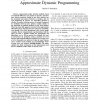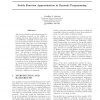33 search results - page 1 / 7 » Pathologies of temporal difference methods in approximate dy... |
CDC
2010
IEEE
12 years 11 months ago
2010
IEEE
Approximate policy iteration methods based on temporal differences are popular in practice, and have been tested extensively, dating to the early nineties, but the associated conve...
ICML
2006
IEEE
2006
IEEE
Automatic basis function construction for approximate dynamic programming and reinforcement learning
13 years 10 months ago
We address the problem of automatically constructing basis functions for linear approximation of the value function of a Markov Decision Process (MDP). Our work builds on results ...
ICML
1995
IEEE
14 years 5 months ago
1995
IEEE
The success ofreinforcement learninginpractical problems depends on the ability to combine function approximation with temporal di erence methods such as value iteration. Experime...
3DPVT
2006
IEEE
13 years 10 months ago
2006
IEEE
The spherical harmonic (SPHARM) description is a powerful surface modeling technique that can model arbitrarily shaped but simply connected three dimensional (3D) objects. Because...
ATAL
2005
Springer
13 years 10 months ago
2005
Springer
Reinforcement learning problems are commonly tackled with temporal difference methods, which use dynamic programming and statistical sampling to estimate the long-term value of ta...


